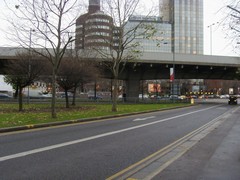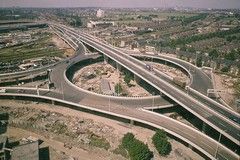Hammersmith Flyover: more than temporary trouble?
Is closure of main London arterial route a sign of deeper problems in the UK's road network?

TfL bosses and London mayor Boris Johnson are adamant that the road will be reopened in time for the London Olympics, but an inside source has told the Fulham and Hammersmith Chronicle that this is 'spinning lies and deceit' on the part of the authorities.
The road, which is one of the main arterial routes in and out of central London, has been shut since before Christmas, when engineers found 'serious structural defects'.
"A solution which will allow the flyover to be fully open to traffic before the Olympics is now being implemented and we will re-open the flyover to traffic as soon as it is safe to do so," said Leon Daniels, TfL's managing director of surface transport.
But according to the Chronicle's source, "TfL are spinning lies and deceit and the media are swallowing it hook, line and sinker. There's a bigger story, which is that it's going to be shut until the Olympics.
"When the Olympics comes along it's going to be open. There is going to be one lane open eastbound and one lane westbound and only for authorised Olympic vehicles. Only cars, not coaches. This will be policed by TfL and the police. Then as soon as the Olympics is finished it will shut again."
The problem - and one that's repeated across the capital and the country as a whole - is that structures such as the Hammersmith Flyover (which was opened in 1959 by none other than Jayne Mansfield but not completed until 1962) are simply reaching the end of their lives.
This is compounded by salt and grit laid during the winter, which causes the concrete's internal cables to corrode.
London's Transport Commissioner Paul Hendy has admitted the gravity of the situation, telling BBC London radio earlier this week that the problems with the flyover are worse than expected.
"We never expected to find any section of it that bad," he said, explaining that the road was intended to have integral heating to avoid the need for gritting. "The under floor heating never worked and over the 40 years it was in existence, before we took over in 2000, clearly salt water has gone steadily into the structure."
Edmund King, president of the AA, acknowledges the possibility of a widespread repetition of the A4 crisis. "This isn't the sort of thing that happened overnight - if it's being monitored properly then you'll know in advance," he told PistonHeads. "Are there other structures that we should be monitoring more closely? More provision should be made for the public to be told of potential problems. The problem in London was that there was very title warning of the closure, so people got stuck."
The biggest concerns centre around early examples of steel-reinforced concrete structures from the 1960s, a time when waterproofing practices lagged behind concrete construction techniques. The legacy of that is a large number of road structures whose structural integrity might be called into question. Dr Chris Burgoyne, an expert in Concrete studies at Cambridge University, told the Sunday Times that "when these flyovers and bridges were built, durability was not seen as so critical a problem. Waterproofing was not done as carefully as it might have been. Now we are paying the penalty."
More alarming still is that, if there is a problem with a particular piece of carriageway that hasn't been regularly monitored (ie if water has seeped into concrete road sections and caused the steel cables to rust) it won't necessarily be apparent until it's too late.
As Garrett Emmerson, head of surface transport at TfL explained to The Sunday Times, "In more traditional bridges you would see deterioration long before you have to question the bridge's structural integrity, but this one will look fine [from the outside] until the last cable pings."
The potentially crumbling state of some roads is an alarming thought, especially when it impacts on some of the key junctions in the UK's road network. And this isn't just speculation - it's already happening: the 85-metre, 3500-tonne bridge that used to carry M6 southbound traffic over the M1 at the Catthorpe interchange has had to be demolished for safety reasons (though it is part of £150m of improvements to the junction), while in 2010 the M6's Gravelly Hill interchange (aka Spaghetti junction), a chronic sufferer of salt-based corrosion, had to have a new support fitted at a cost of £2.7m.
The nearby Ray Hall viaduct where the M5 meets the M6 is also having £10.5m worth of repairs made to 13 concrete columns, while Middle Engine Lane bridge near Newcastle has £500,000 of improvements earmarked to repair cosmetic corrosion.
In London the situation is less clear, with TfL rather than the Highways Agency taking responsibility for most of the road network; if the problems with the Hammersmith flyover were to be repeated on the Westway, parts of the North Circular, or the Eastway - essentially any of the older elevated roads in the capital - it's uncertain what (or whether) plans are in place for refurbishment or rebuilding.
The big question is, can a public purse that's under so much pressure afford to support the refurbishment and rebuilding of key parts of our transport infrastructure? More to the point, can it afford not to?
Images: Kayode Okeyode and Shaun Ferguson
Gassing Station | Motoring News | Top of Page | What's New | My Stuff







